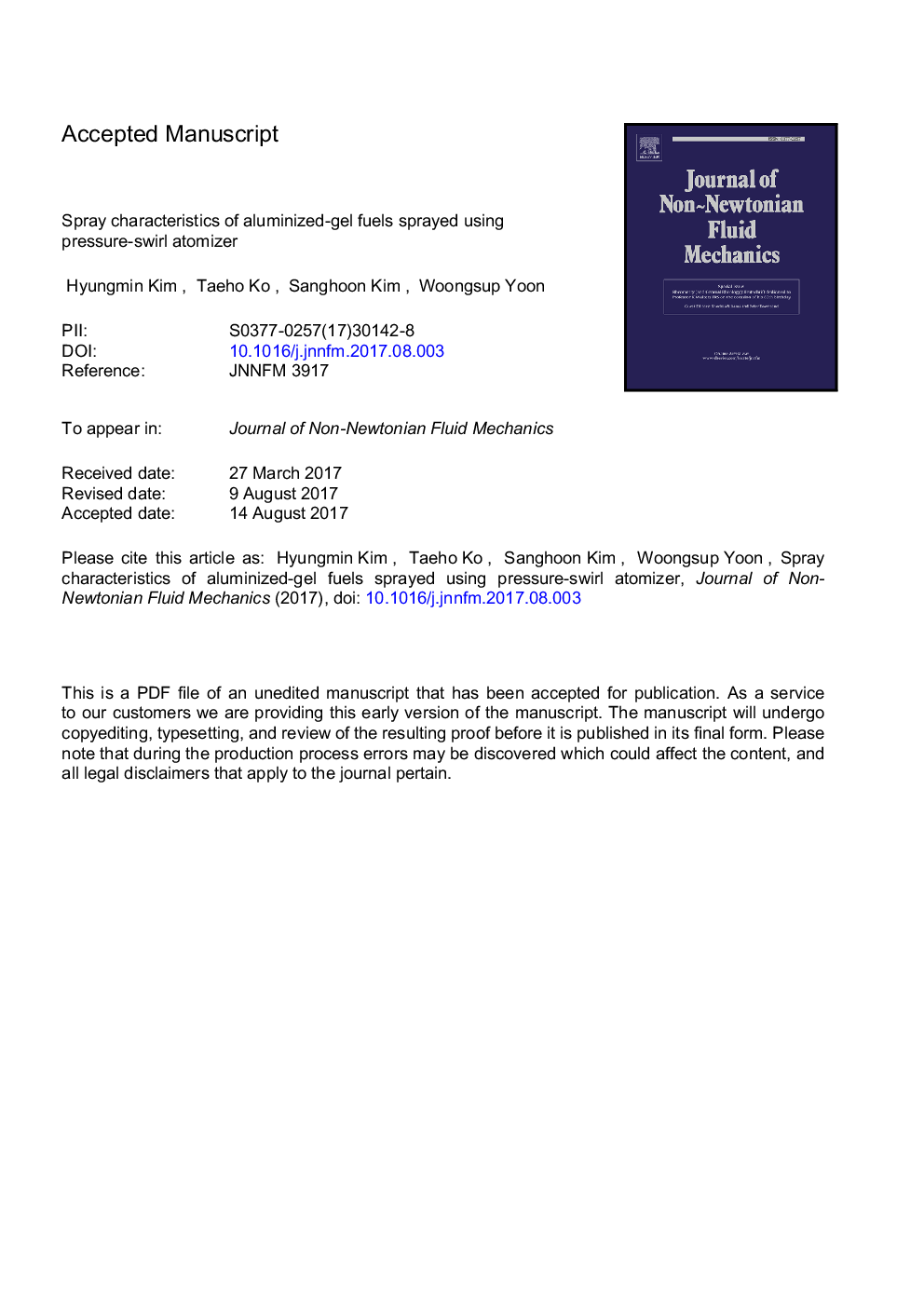| کد مقاله | کد نشریه | سال انتشار | مقاله انگلیسی | نسخه تمام متن |
|---|---|---|---|---|
| 4995489 | 1458991 | 2017 | 27 صفحه PDF | دانلود رایگان |
عنوان انگلیسی مقاله ISI
Spray characteristics of aluminized-gel fuels sprayed using pressure-swirl atomizer
ترجمه فارسی عنوان
ویژگی های اسپری سوخت های ژل آلومینیوم اسپری با استفاده از دستگاه اسپری تورم فشار
دانلود مقاله + سفارش ترجمه
دانلود مقاله ISI انگلیسی
رایگان برای ایرانیان
کلمات کلیدی
ویژگی های اسپری، اسپری چرخش مایع فیلم مایع، پالس اتحاد
ترجمه چکیده
سوخت مایع یک مایع غیر برشی نیکنونی با ویسکوزیته بالا است. سوخت دارای تراکم انرژی بالا است و دارای مزایای در کنترل تغذیه است. هنگامی که سوخت مایع با استفاده از یک اتمیزر چرخان تزریق می شود، ویژگی های اسپری تغییر می کند، زیرا خصوصیات رئولوژیکی آن ها متفاوت از سوخت مایع معمولی است. به طور خاص، سوخت های فلزی موجود در دوغاب یک پارامتر مهم است که بر خواص رئولوژیکی، مکانیسم شکستن و عملکرد اسپری چرخش مایع متمرکز است. در این مطالعه، به منظور بررسی اثر ذرات آلومینیومی بر خصوصیات اسپری سوخت مایع، یک آزمایش تجربی انجام شد. خواص رئولوژیکی (ضایعات برشی ویسکوزیته)، جریان جرمی و ضریب تخلیه ترکیب مایع، اندازه گیری شد و تأثیرات ذرات و قطر متوسط بر ویژگی های اسپری سوخت دیزل توضیح داده شد. محتوا و میانگین قطر ذرات در مقایسه با ویسکوزیته دوغاب متناسب بوده و رفتار جریان در رابطه با ذرات تغییر می کند. همانطور که ویسکوزیته به دلیل ذرات افزایش می یابد، سرعت جریان جرم و ضریب تخلیه به علت افزایش ضخامت فیلم مایع افزایش می یابد. ژل کراسنس و اسپری چرخش مایع به وسیله یک مکانیزم آیرودینامیکی فرآیند شکسته شدن ایجاد می شود و رباط های شبانی مانند ایجاد می شود که به دلیل افزایش ویسکوزیته در روغن نبوده است. همانطور که افزایش فشار تزریق می شود، فرکانس پالس تولید شده در فیلم مایع افزایش می یابد و رباط های شباهت به آن ضخیم می شود. هنگامی که محتوای ذرات کاهش می یابد، پدیده ی مشابهی اتفاق می افتد. با افزایش میزان ذرات، طول انقباض با افزایش ضخامت فیلم مایع افزایش می یابد. با این حال، مکانیزم شکستن بسته به ضخامت فیلم مایع تغییر می کند زمانی که میانگین قطر ذرات تغییر می کند. زاویه اسپری به طور معکوس مربوط به تغییر ویسکوزیته به علت ذرات است.
موضوعات مرتبط
مهندسی و علوم پایه
مهندسی شیمی
جریان سیال و فرایندهای انتقال
چکیده انگلیسی
A slurry fuel is a non-Newtonian shear-thinning fluid with high viscosity. The fuel has a high energy density and has advantages in feed control. When the slurry fuel is injected using a swirl atomizer, the spray characteristics change because the rheological characteristics are different from those of the conventional liquid fuel. In particular, the metallic fuel contained in the slurry is an important parameter that dominates the rheological properties, breakup mechanism, and performance of the slurry swirl spray. In this study, an experimental analysis was performed to investigate the effect of aluminum particles on the spray characteristics of the slurry fuel. The rheological properties (shear-viscosity traces), mass flow rate, and discharge coefficient of the slurry composition were measured, and the influences of the particle content and mean diameter on the spray characteristics of the slurry fuel were explained. The content and mean diameter of the particles were found to be proportional to the viscosity of the slurry, and the flow behavior changes with respect to the particles. As the viscosity increases because of the particles, the mass flow rate and discharge coefficient increase because of the increase in the liquid-film thickness. The kerosene gel and slurry swirl spray undergo a breakup process via an aerodynamic mechanism, forming web-like ligaments, which do not appear in the kerosene because of increase in viscosity. As the injection pressure is increased, the frequency of the pulsation generated in the liquid film increases, and the web-like ligaments tend to be dense. When the particle content decreases, the same phenomenon occurs. As the particle content increases, the breakup length tends to increase with the increase in the thickness of the liquid film. However, the breakup mechanism changes depending on the thickness of the liquid film when the mean diameter of the particles changes. The spray angle is inversely related to the viscosity change due to the particles.
ناشر
Database: Elsevier - ScienceDirect (ساینس دایرکت)
Journal: Journal of Non-Newtonian Fluid Mechanics - Volume 249, November 2017, Pages 36-47
Journal: Journal of Non-Newtonian Fluid Mechanics - Volume 249, November 2017, Pages 36-47
نویسندگان
Hyungmin Kim, Taeho Ko, Sanghoon Kim, Woongsup Yoon,
